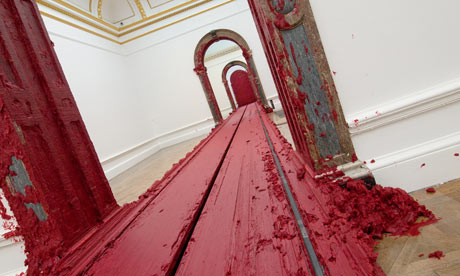
Anish Kapoor, "Svayambh," 2007. Photo: Christian Sinibaldi, The Guardian.
There’s a big lump of birdshit in the eye of Joshua Reynolds. The painter and founder of the Royal Academy, who once literally took a Titian painting to bits to better understand how he did what he did, stands immortalized in bronze in the Academy’s courtyard, waggling his metal brush reprehensively at a wall of giant stainless steel bubbles by Anish Kapoor, a more recent member of the Academy whose mid-career retrospective dominates the galleries of the building behind. The birdshit has landed capriciously, streaked in the sculpture’s eye, but it’s tempting to read it as clunky metaphor for Kapoor’s all-out assault on the neo-Palladian austerity of the Academy and the art-historical “standards” it represents. One in the eye for the stuffed shirts!
Kapoor has dragged, dripped and splashed thick gloops of paint all over the place, firing it out of a cannon, slathering it on doorways, and dusting it on the floors and walls. And yet there’s a kind of timid politeness about much of Kapoor’s work, a willingness to stay within the boundaries of expectation. As one woman I overheard put it, “it’s institutionalized bad manners.” Or, in the words of a snarling teenager, looking at a particularly gloopy pile of paint: “rank.”
The two big attractions of the show are, probably befitting the artist’s work as a whole, the biggest and most spectacular ones. Shooting into the Corner (2008-9) takes up two (very large) rooms of the RA. Pallets stacked high with bucket-size paint cartridges line one wall, and a cannon is positioned pointing into a second room, where a gungy Rorschach of burgundy paint (actually paint, wax, and Vaseline) has built up. There are red globs on the molding, acne on the cornicing. An intense young museum guard loads the cannon, and a fresh lump of colored stuff thunks against the wall. I think we’re meant to think about Smithson, Serra, Pollock maybe – the ‘canon’ (oof!) of modern drippers and dribblers – but the work’s insistent undertone, and that of much of the work here, is that of the single entendre: it really is a big cannon firing gooey stuff into the corner of a room. Geddit?
The crudeness of Kapoor’s metaphorical language redeems him, sometimes, from being yet another vainglorious public artist along the lines of Antony Gormley, with whom he shares the dubious honor of being Britain’s (maybe the world’s?) most successful public artist. Kapoor may shun the term (in a Guardian interview a year ago, he claimed that he “hate[s] public sculpture…oh God, even the phrase makes me feel tired”), his work (like New York’s Sky Mirror, or Chicago’s Cloud Gate) lends itself to the public arena particularly well: it’s big, phenomenological, a bit bodily, and offers a mildly transformative physical experience of disorientation. You get what you pay for, too. Kapoor never cuts corners, and the show here fluctuates between conspicuous wastage and the blinged-up finish fetish; you can see why the investors have been keen to hop on board. And there’s something indubitably guilty-pleasurish about seeing what are, sometimes unintentionally, onanistically self-indulgent works of art made in a time of economic asceticism.
Kapoor’s work draws on art historical precedent, but almost invariably softens the blow. We get echoes of Michael Heizer’s vast slicings and dicings, Robert Irwin’s infinitely subtle investigations of sight and space, and Richard Serra’s elephantine steel curls, but it’s filtered through an overt willingness to play to the gallery. It doesn’t always work. His mirror pieces, a whole room of which follow on from the cannon, make you big or small or bendy, but they’re no match for a funfair hall of mirrors, let alone the Robert Morris or Pistoletto works to which they ostensibly nod. Having said that, the brasher and camper Kapoor gets, the better. When he gets “deep,” as in his room of pointless concrete turds excruciatingly entitled Greyman Cries, Shaman Dies, Billowing Smoke, Beauty Evoked, it’s like being trapped in a lift with a stoned 16-year old who wants to read you his poetry.
The centerpiece of Kapoor’s show takes up five large galleries. Entitled Svayambh (Sanskrit for “self-generated”), it’s a huge block of the same red paint/wax/Vaseline mixture of the cannon piece, set on a train track which travels, very very slowly, from one gallery to the other, over the course of about an hour and a half. As it passes from room to room – it’s the same width and height of the doorways — it leaves behind a thick residue of stuff. The tracks are clogged with fat piles of fallen-off goo. The association might be that of penetration, or even digestion, but the weird, stately grace of the thing, its insistent, inevitable, lugubrious travel, gives it a presence outside of its apparent one-linerness. It’s a reminder that large-scale “public” art (and, in essence, that’s what this is) can transcend the crudities of the blob in the plaza and use scale and spectacle as transports of delight.